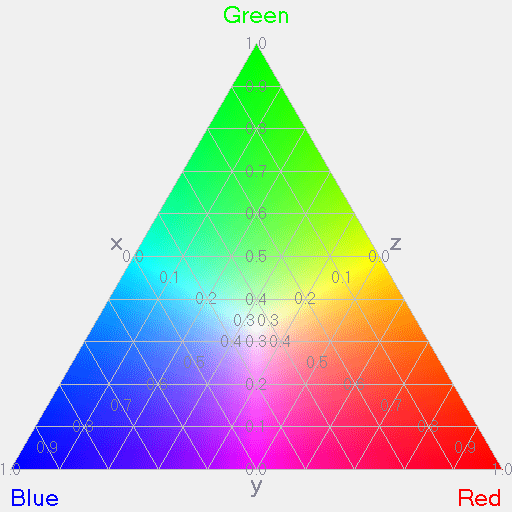 |
Maxwell Colour Triangle | Maxwell Legacy Concepts |
|---|
In a nutshell |
Maxwell laid the foundations of colour science, the ability to measure colours quantitatively. The basis of his method is the use of 3 primary coloured lights that can be mixed in variable proportions to produce most other colours. The Maxwell colour triangle represents this process. The corners of the triangle are the primary colours; points along the triangle edges represent colours achieved by mixing 2 primary colours. Points within the triangle represent quantitatively the colours obtained by mixing the 3 primaries in varying proportions. |
 |
|---|
| Technical detail | Maxwell's interest in colour began when he was a schoolboy. By the time he was a student at Cambridge he had developed a spinning disk with coloured sectors on it whose size could be adjusted so that when the disk was spun the blurred colour matched a given colour. From numerous trials he concluded that only 3 coloured sectors were necessary and the match did not change when only the brightness of illumination was changed. He realised, though, that coloured sectors made of card were not a readily reproducible reference and that he needed to choose primary colours found in the spectrum of light. It was after leaving Cambridge and becoming Professor of Natural Philosophy at Marischal College, Aberdeen, that he devised an apparatus now known as the Maxwell colour box with which he could measure the amount of primary spectral colours needed to match any other colour, either another spectral colour or colour of an object. The match can be written C ≡ aR + bG + cB, where C is the colour to be matched, R, G, B are the chosen primaries and a, b, c, record the amount of each primary. a, b, c, are the measure of the colour C. Multiplying a, b, c by a constant factor just changes the brightness of the colour so usually a + b + c = 1 is chosen in suitable units. Maxwell had found a complication that certain colours needed one primary to be added to the test colour before a mixture of the remaining two primaries could match the mixture of test colour and added primary. This difficulty is handled in the relationship by allowing the coefficient a or b or c associated with the added primary to be negative. The colour box allowed for negative coefficients but the Maxwell colour triangle doesn't, which is why one has to say that 'most' colours can be represented by the Maxwell colour triangle. Since electronic colour displays like TV's, mobile phones and PCs use 3-colour mixing technology, they too are not able to display certain colours correctly. 3-colour mixing is built into the standard technology for transmitting coloured images so there is no easy path to upgrade colour reproduction to say 4-colour mixing that would increase the range of colours accurately reproduced. In fact we don't really notice the defect. Modern colour measurements are made using a system of primaries overseen by the CIE (La Commission Internationale de l'éclairage). The mathematics of 'colour space' is used to generate 3 primaries that don't correspond to actual colours but allow all real colours to be expressed as positive mixtures of them. In the CIE system all real colours have positive coordinates. The 'colour triangle' now becomes a distorted shape with rounded sides of the CIE chromaticity diagram but the concept behind it is just the one Maxwell laid down in the late 1850s. References: In spite of its huge practical importance, colour science is often not given the space it deserves in books on light and optics. A 'classic text' on the subject is W. D. Wright "The Measurement of Colour" Hilger, London, 1969. Maxwell's colour triangle and related colour images can be generated by programs at http://www.efg2.com/Lab/. JSR 2016 |
 |
|---|